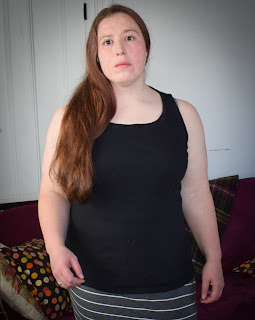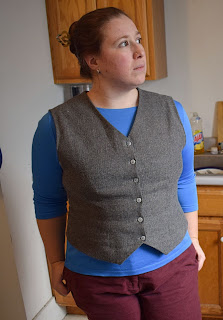Cockatoo Brae
 |
| Trying on the finished sweater |
Cockatoo Brae is a Kate Davies pattern, with a plain body and shetland style yoke of stars and trees. I fell in love with this pattern back when the book was first published. I bought the yarn for my version at Kathy's Knits in Edinburgh Scotland, while on a trip to walk the West Highland Way and spend a few days in the city. I used the pattern yarn (not something I always do) but switched the colors - light heather grey for the body, white for the yoke background, and a truncated rainbow in purple-blue-green for the patterning. I chose colors in fairly similar values, so the whole thing would read similarly from far away.
I am different from the pattern as written in pretty much every dimension, as well as not getting the intended gauge. So I basically mathed out the starting number of stitches and figured I would work out the rest as I went. And then I got it wrong - my gauge for the sweater was tighter than I had calculated, so my 300 stitch sweater was going to work out to be 2.5" too small. So I ripped it out and started again. 323 stitches cast on, 7 steek stitches and the rest body worked in the 2x2 twisted rib as written. I did work a false seam on the sides to help it hang better, since I worked the whole thing in the round. At this point any math or size selecting I'd done at the beginning was moot, since my gauge and stitch counts were pretty far off from the original.
I did work waist shaping, as well as adding vertical bust darts. I increased 7 stitches each side below the bust, and then decreased them out during the yoke shaping before the stranded pattern. I'm not sure exactly what I did for the waist though.
I started on the sleeves, casting on 56 stitches and knitting the twisted rib as written then going to increases every 5 rounds, originally planned to get up to 120 stitches. However, I decided after about 6 inches that the sleeves were working out too tight. I think partly due to casting on a bit too few stitches, but also because while my actual wrist isn't particularly large I do have a fair amount of forarm and the sleeve was not actually growing fast enough. The project then hibernated for about 3 years, and every time I looked at continuing the idea of starting by ripping out the sleeves was too much.
Then in November of 2019 I decided it had been Long Enough, and I still really wanted that sweater. So I ripped out the sleeves, re-skeined and washed the yarn (to calm the kinks from three years of being knitted) and balled up the yarn. I started from the same yarn I had been using, because due to an Incident involving moths and the microwave I had two different dye lots and I'd decided to work the sleeves in the new yarn to minimize lines. (there were moths, it turns out you can pretty easily kill moth eggs in the microwave but it will burn your yarn if you run it too long)
Knitting sleeves two at a time is definitely the way to go if you care about the sleeves matching (at least for me - repeatability is not my strong suit). I cast on 60 stitches, and then increased 4 in the first knit round. After that I started with double increases each side of the purl false seam every 5 rounds, then once I got to about 3 inches from the cast on I switched down to increasing every 6 rounds. Once I got up to 102 stitches around I dropped to increasing every 8 rounds. This increase pattern created more space early in the sleeve, and then less growth further up the arm, which pretty nicely matches my arm shape.
I'm not actually sure how many stitches I ended up with - I originally planned on 120, but I think I ended up closer to 112 based on 15 stitches set aside at the underarm (counted on the finished garment). I do have notes that I the stitch counts were 74-97-143-97-74 across the front right - sleeve - back - sleeve - front left, after joining on the arms and doing two sets of bust dart decreases. I worked the yoke shaping for a size 9, because I had 485 stitches at that point (including the bust darts that would end up being decreased out) which was closest to the size 9 number.
I also wanted to make sure the depth of the yoke was right, since my row gauge was also off from the pattern as written. The yoke depth for the size 5 (with a bust 41 1/4" as written) was 8 inches. At the pattern gauge of 9 rows per inch, that's 72 rows in the yoke. At my gauge of 11 rows per inch I would need 88 rows. The size 9 has a depth of 9 3/4" with the pattern gauge, which will be 87 3/4". Pretty much perfect. From this point I can just follow the pattern for the size 9 as written, and know that with the gauge math my shoulder area will turn out the right proportions (blessed be pattern writers who provide thorough schematic measurements). It probably would have worked to pick the size 9 based on the number of stitches I had when joining the sleeves to the body, but if my stitch to row gauge was off it could have ended up wonky.
It's worth noting that the proportion of the stitches for the sleeves versus the body in my sweater are pretty significantly different that the pattern as written - the pattern as written for size 9 should have 76 front stitches, 88 sleeve stitches, and 152 back stitches. I've got 9 more stitches in each sleeve, and 9 fewer across the back. I'm only 2 fewer on the fronts, but that's mostly because I have 5 extra stitches on each front for the bust darts that still need to be decreased out. But for this shape of sweater, as long as the total number of stitches are correct the distribution isn't hugely important. I did have to do a bit of adjustment (by one or two stitches) to get my final count to match the pattern as written for the colorwork, but it was minor.
 |
| Yoke goes zoom! (image of partially finished sweater yoke) |
The yoke was fast and easy, and very satisfying. I was pretty careful with the floats, and it doesn't seem to have drawn in dramatically or anything like that. I did work a couple of short rows across the upper back before the yoke pattern, mostly as written, and a couple of extra short rows across the back of the neckline (not included in the pattern, but a couple of other people noted it) to keep the neckline from being too low in the back.
 |
| Trying on the sweater before cutting the steek |
I did a crocheted reinforcing on the steek, with some white sock yarn. I didn't have the right size crochet hook, my choices were too big or a tiny beading hook, so the crochet isn't as neat as I would like, but it's not the end of the world. I picked up the stitches for the button band by knitting into every stitch along the front, and then purling back decreasing every third stitch (purl two, purl two together) going to 3 stitches picked up for every 4 rows. I then started the twisted rib. This creates two rows of stockinet right up against the front panel, but it makes the picked up edge much cleaner since every row on the body has a band stitch in it so there's no unevenness. If I were doing knitted facings I would probably have gone to purl one purl 2 together (so 2 stitches for every 3 rows) which is closer to my stitch-row gauge ratio, but with the rib 3 stitches for 4 rows works well.
 |
| Interior steek finishing, front bands, and snaps |
I finished the sweater with snaps, because by the time I got there it was mid-pandemic, the local shops were closed, and I had them on hand. Honestly I think I would have gone with snaps anyway - they don't distort the front band the way button holes do, and you don't have to work out where they go ahead of time. I gave it a bath and lightly blocked it into shape, and was good to go!
This project had a lot of twists and turns, and involved more math than I had originally intended (that's kind of a given when you don't even try to get gauge), but it's one of my favorite finished objects. I wore it all the time last spring, and broke it out again as it started getting cold. It fits beautifully, I love the fabric, and the style suits me. It was worth the five years it took between casting on and actually finishing.



Comments
Post a Comment